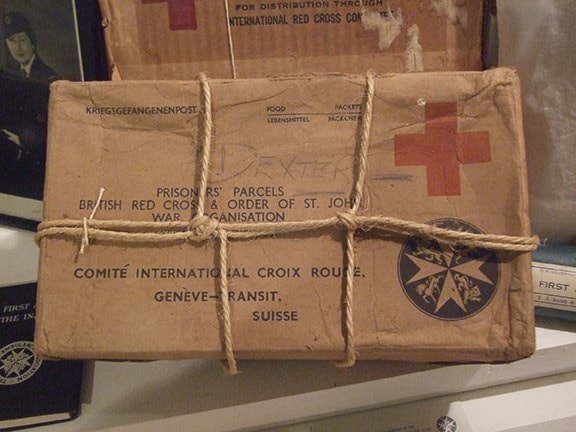When they returned, the tables were decorated with red and white crepe paper and at every man’s place was a decorated cake, a new Red Cross face cloth, each a different colour, and a place card.
For many Allied POWs in both world wars Red Cross parcels made all the difference between the success — or not — of Christmas behind barbed wire.
Being an unwilling guest of the Third Reich or the Imperial Japanese Government was something to be endured not envied. Besides the day to day struggle to survive POWs had to create ways to keep their minds active and to maintain their morale. For most, Christmas was, in fact, a depressing day: one of thoughts of families and home and the frightening uncertainty of ever seeing either again.
Sometimes it was more ingenuity than anything else that saved the day, particularly as that described by R.L. Masters in the 1985 Victoria published book, In the Clutch of Circumstance: Experiences of Canadian Prisoners of War, edited by Tony Strachan for Cappis Press in 1985.
Masters tells how he shared a hut with 19 other prisoners (including Canadians, British, Australians, New Zealanders and Americans,) that was blessed, truly blessed, with Monty, who was not only their leader but a fine chef, and a tin stove. Between the two of them they turned out a Christmas dinner never to be forgotten.
First, everyone pooled their Red Cross Christmas parcels, each one containing a 12-ounce can of turkey, a plum pudding, six ounces of stewed cherries, eight ounces of candy, eight ounces of cheese and some honey, dates and nuts. For some time Monty had been baking 20 individual cakes, one for each man, and a larger one for sharing. With a few carrots, the bouillon cube consommé, onions and rye flour traded from the guards for cigarettes, Monty added dry bread crumbs, margarine and Klim powdered milk, pouring the mixture into nine prune boxes and baking them in the ashes of the heater. With icing made from D bars (emergency chocolate rations with added vitamins) for mortar, he “built the nine cakes like a wall”.
But he wasn’t finished. After roasting prune stones he ground the kernels to powder and mixed it with Klim, sugar and margarine. No one, swore Masters, could tell Monty’s jury-rigged mix from real marzipan. This, he spread over the cakes with half an inch of chocolate bar icing.
For variety he crumbled and dried the centres of German rye bread (discarding the crusts because of their unpleasant taste) and mixed with margarine, raisins, prune chips, apricots and some carrots, all “flavoured with roasted prune kernels and a touch of cinnamon”. Soda bicarbonate, the key ingredient necessary to making them rise, had been liberated from their medical stores.
When all was ready the cakes were baked in Klim tins on top of the stove, three at a time beneath an inverted pail, and decorated with pink and white icing applied through a tube made from another Klim tin.
So much for the cakes. Monty now supplemented the plum puddings provided by the Red Cross with his own made of rye bread, prunes, raisins and carrots. Placed in a bowl this pudding was tied in a cloth and submerged in boiling water for five hours, to be served with his own sauce of turnip jam, Klim and sugar.
Monty also had a flair for the dramatic. An hour before dinner he shooed everyone out of the hut while he set the table. When they returned, Masters recalled with obvious awe, the tables were decorated with red and white crepe paper although he didn’t explain how this frill was obtained. At every man’s place was a decorated cake, a new Red Cross face cloth, each a different colour, and a place card!
And let’s not forget Monty’s (we must assume hand-lettered) menu: Consommé, turkey with potato chips seasoned with onion, plum pudding with Klim bash sauce, Christmas cake, nuts, candy, crackers and cheese. Oh, and tea and coffee, all garnished with some “mild” Swiss fireworks, followed by singing to the accompaniment of their in-house orchestra consisting of a piano accordion, saxophone and clarinet.
For the final gastronomic touch of that remarkable and memorable Christmas Day in the depths of the Second World War, biscuits with jam, cheese, honey or “a special concoction” of pineapple jam mixed with cocoa that, Masters assured readers, was not only unique but delicious!
Writing almost 40 years later, that Christmas dinner in a German prison camp remained as vividly fresh in Masters’ memory as it likely did in the memories of all 19 men who’d shared his hut. All thanks to those priceless Red Cross parcels, a tin stove and Monty, the man with a wizard’s culinary touch.
www.twpaterson.com
